At the end of July, I went to my first in-person Battletech event at a store in Toronto. It was a King of the Hill-style battle royale set on Solaris VII (the Battletech universe’s version of Vegas). I had a lot of fun (though it legit took me several days to recover) and wanted to put together a quick after action report for posterity. Instead, some real life stuff got in the way and this sat in draft for way too long.
I won’t get into the details around why and how I wound up at this event. My partner and I went through a pretty quick move (in terms of timelines, we were long overdue to move) last August and it left me reeling. My usual hobbies weren’t helping with the anxiety and burnout. I could barely bring myself to get to the final-ish missions of the first playthrough of Armored Core VI, a game that I’d been looking forward to for ten fucking years. So I did what any completely reasonable person who went through a major life change after the age of 40 does: I purchased a book on military history and devoured it. Early in 2024, a friend suggested I look at Warhammer and I got into Kill Team, the skirmish-focused version of Warhammer 40,000, and then into Battletech this past May – a tabletop game and setting I’d admired from afar, but hadn’t realized it had been so thoroughly revived in the past few years (though I’ve played basically every PC release of MechCommander, Battletech, and Mechwarrior).
I’m writing this from the assumption that the reader knows roughly what Battletech is as both a tabletop game and general setting. This timeline from Polygon that came out around the release of the Harebrained Schemes Battletech PC game gives a great overview of the setting up until the start of the Clan Invasion era. The general pitch is: it’s a science fiction wargaming setting focused on mech-on-mech violence. There are two major rulesets for Battletech right now (Classic and Alpha Strike), both enjoying a decent growth in popularity after several decades where the IP seemed doomed to wander the intellectual property hinterlands. In a lot of ways, it’s amazing that Battletech continues to exist as a going concern at all, much less thriving.
Classic Battletech (sometimes referred to as Total Warfare) is some grognard-ass grognard wargaming. Think of it like a super-detailed WWII wargame that’s set in a period of history that never happened. A game between two players with four mechs apiece can take several hours to play out. Larger engagements featuring a more combined arms approach would usually take an entire weekend to play. These rules are very much a product of a particular simulation-first design acumen that was super popular in wargaming through the 70s and 80s. The rules have seen some updates over the years, but there’s plenty of rough edges and any given turn, you’re probably rolling on four or five different tables every time you attack with more than one weapon on your mech. It’s cool as hell if you have the time and patience for it. It produces some spectacularly cinematic moments. It just, y’know, doesn’t fit into the lives of most mortals.
The other ruleset is Alpha Strike. This has been around for a while in various forms but now has a dedicated starter box. Alpha Strike abstracts a lot of the crunchy simulation-first aspects of Classic in favour of streamlining the rules to either let you finish a regular 4v4 mechs-only game in a reasonable amount of time, or to accommodate larger combined arms engagements over the span of a few hours. I love Alpha Strike so much. It’s such an elegant design that still evokes some of the best moments of Classic Battletech, but does so in a way that feels so much less exhausting to play. I love artillery mechs, I love infantry, I love weird tripod mech designs. I will never have the patience to coallate all the rules for those individual things to have handy as a quick reference for a pickup Classic Battletech game. If I want to run them with that ruleset, I’d just use something like MegaMek to automate a lot of that stuff (MegaMek fucking rules by the way). However, all of those things are pretty simple to put on the table in Alpha Strike. Also, because Alpha Strike uses a different balancing system, mechs that are actively shitty in Classic Battletech (some mechs just have bad variants for Lore Reasons and I love them) can be decent or even excellent. By the same token, absolutely broken mech variants are much more balanced in Alpha Strike.
Alright, let’s get into the AAR. I’ll probably do some follow-up posts to get into the weeds on the distinction between these rulesets and getting started with the game at a later date.
The Format
Ruleset: Classic Battletech (specifically anything in the Battlemech Manual – this rules out bringing vehicles or infantry).
List requirements:
- Minimum 2 mechs.
- Inner Sphere technology only.
- Clan Invasion era (the year 3061 or earlier).
- Total value of the force may not exceed 2000 BV (including piloting and gunnery adjustments).
- Custom mechs weren’t overtly banned but from the wording, seemed to be discouraged.
Terrain and Setup:
- There will be a three-hex raised summit in the middle of the board. When a mech ends a round on one of these hexes, the owner scores one point. For two consecutive rounds on the summit, the owner scores two points, then three, then four, and so on.
- One point will be scored each team for each enemy mech killed. To receive credit, one must have done damage to a mech during a turn in which it died.
- No teams allowed.
- Mechs are available if you don’t have any to bring.
Optional Rules Used:
- Playing Card Initiative
- Movement Dice
- Sprinting
- Backward Level Changes
- Floating Crits
- Careful Stand
- Active Probes Targeting
- Enhanced Flamers
- Retractable Blades
List Building
My main consideration is that I wanted to use mechs I liked and had painted to a reasonable standard. When designing a list, I normally pick the heaviest mech I want to bring and design the list around that. However, I flipped this approach on its head because 2000 BV isn’t a lot to work with and I don’t have a lot of miniatures for light mechs that would make sense in this format. One of my favourite light mechs is the Spider and I genuinely love the new Catalyst sculpt, so as much as I normally pick the anchor first and work cheaper from there, I decided to use the Spider as my starting point. I had two general concepts in mind going into this:
- Brick Shithouse + chaff. This feels a little cheesy, because the secondary mech is just there to fulfill the list-building requirements to have two mechs.
- Jumpy Pulse Bastards with melee capability. There’s a lot of upside here. An all-energy loadout means I don’t have to worry about ammo bin explosions. Part of why I love the Spider is that its lasers are in its torso, meaning it’s free to punch with both fists during the physical attack phase (not that the punches do much damage, but getting a chance to get a head shot is worth it). Plus, the similar profile between the two mechs will cut down on the cognitive load. I won’t need to track ammo, either.
Trouble in the Brick Shithouse
One of my favourite assault mechs is the Banshee. For one, I was very swayed by the Goonhammer Overview, but I also love the sculpt for the Banshee in the Inner Sphere Heavy Lance box. I’m not super fond of how the canopy for this guy came out, but this might’ve been a good incentive to try to correct that. I looked at the 3Q, which would’ve been a prime slab of cheap beefcake to plunk down (foreshadowing). With standard stats (gunnery 4, piloting 5), a 3Q comes in at 1394 BV, carries an autocannon/20 (usually shortened to AC/20). Autocannons are weird in that it’s not always clear if the number afterwards refers to the number of shots fired per volley or if it’s denoting the size of the rounds fired. In terms of game mechanics, the number refers to the damage done to a single location if the weapon hits. So an AC/2 does two damage per hit. An AC/20 is the finger of god in early Battletech. Technically, gauss rifles exist somewhere out there, but they’re not at all easy to come by in this era and certainly not on a mech with a sub-2000 BV price tag. An AC/20 shot will reliably take a limb off most light mechs. A head shot will take out just about any mech I can think of, regardless of the era. They’re short range, but that’s an ideal weapon to bring to a fight like this. We’re all eventually going to fight over that summit and it’s going to be close range. In hindsight, I’m a little surprised nobody brought a Hunchback (one of the more popular/cheaper ways to put an AC/20 on the table).
The Spider I most had in mind for this mission is the 7M, a 3051 update to the 5V that replaces the stock medium lasers with pulse lasers. Unless I get up to some fuckery with my pilots to make them *worse*, the Banshee BNC-3Q and Spider SDR-7M come in at 2016 BV – too expensive. I didn’t really have a Locust variant I was in love with at a sub-600 BV price point and really felt like I needed jump jets on the light if they were going to be worth a damn. I could have gone to the local shop near me that stocks IronWind Metal minis and picked up a Dart. It doesn’t have jump jets but moves fast enough and has an all-energy/single weapon type loadout. I looked at the Firestarter, Mongoose, and Wolfhound, and found that basically all of them were more expensive than the Spider. I did have a Wasp, but it was *way* cheaper in terms of BV and I wasn’t loving how the Wasp’s paint job was coming out. I didn’t want to have to go through the trouble of stripping and repainting it followed by figuring out how to rejigger piloting and gunnery skills to make the list make sense. Okay, so let’s bench the Banshee for now.
Meet the Jumpy Pulse Bastards
The rationale behind this list has its roots in what Solaris VII is supposed to be. But first, the thing you need to understand about the Battletech universe is that the IP has changed hands a fair few times, but its foundations were laid in the 80s and not with a great deal of care. The writers didn’t quite know if it wanted to be a Saturday morning cartoon or a Serious Political Drama or a bleak satire of the excesses of monarchist rule and the seemingly inescapable pull of fascism (the answer is probably: whichever one was making money). You can make the same claims about Warhammer, but Games Workshop has been more willing to jettison whole sections of its lore and history if they didn’t think the vibes fit. I’ve been reading through the Michael Stackpole warrior trilogy books lately and hands-down, the best sections are set in the gladiatorial arenas on Solaris VII. Stackpole is very good at describing mech-on-mech combat without it feeling like he’s “that’s chappie”-ing his way through a list of weapons and mechs in the universe. Outside of that, most of his descriptions of adulthood (specifically the behaviour of adult men) reads like a list of 70s and 80s men’s magazine cliches: brick-jawed guys in turtlenecks and corduroy drinking brandy from a snifter at a ski lodge in space Aspen and they all smell like English Leather cologne.
However, during one particularly fun encounter in the arenas on Solaris VII, I clocked that Stackpole is basically describing a laser tag maze. Don’t get me wrong, I loved laser tag. That shit was cool as fuck in the 80s and 90s. I still think it’s a great way to kill a half an hour, but there’s a certain familiarity that’s crept in over the years. Put another way: these books were written by someone who probably looked at American Gladiators and was like “this is the future of televised gladiatorial spectacle” (and it was, even if the world disagreed) but the intervening years have rendered what might’ve felt edgy and novel in its day kind of quaint. However, that’s kind of the vibe for Solaris VII. It’s simultaneously an extremely seedy underground cage fight business where people are frequently killed on screen and a cartoonish televised spectacle watched throughout the Inner Sphere by the young and old. That tension is, to my understanding, never really resolved. However, one uniting tendency between these orthogonal tonal landscapes is that people like it when mechs punch each other. So that’s what I wanted to give the assumed audience of this grudge match: mechs who are strong and can punch (or hatchet).
The Spider 7M isn’t the most mobile or heat efficient Spider (and often pays for that with its life) but it has two medium pulse lasers (which are pretty efficient from a heat-to-damage ratio) situated in the center torso. Pulse lasers add a -2 bonus to your chance to hit (reducing the difficulty of hitting whatever target you’re aiming at) and jumping adds +3 to your difficulty. You roll your chance to hit independently for each weapon you’re firing, so the pulse lasers mostly negate the shooting disadvantage you get from jumping. In Classic Battletech, you declare physical attacks in the phase after the shooting phase. This means if you shoot a weapon located on an arm, you can’t punch with that arm (or use a hatchet, which we’ll get to in a minute). For this Spider to even have a shot at doing a decent amount of damage, I’m going to need it to be able to jump around to make itself harder to hit, ideally get some shots on the rear armour, and connect with its punches for bonus damage. This gets hairy if you’re jumping as far as possible every turn and trying to shoot both pulse lasers, but it would be a good lesson in managing heat and learning to play cagey.
Hatchets in Battletech have an uneven history. They look cool as fuck, but a lot of hatchet mechs aren’t well-designed. Mechanically, hatchets do more damage than a punch, can roll on the whole mech location table (meaning you have a chance at hitting the head) and are a little easier to hit than punches. However, kicks have an even easier to-hit chance than hatchets, and if you connect, you can force a piloting roll to see if your opponent topples over. Unless there’s a level difference and you’re standing above your target, your kick isn’t going to have a chance to hit your target’s head or torso. Also, if you miss with a kick, you get to make a piloting roll to see if you get to spend a turn flopping around like Joel Embiid. The first potential hatchet mech I could pair with the Spider is the Hatchetman, an okayish medium mech. A lot of its variants have a bunch of weapons on the hatchet arm, meaning every turn I’d need to decide if I wanted to shoot or hatchet someone. There are way better variants in the line, but most of them show up in later eras than the one we’re playing in. I love the look of the Hatchetman and want to run them more frequently, but that also means convincing people to move past the Succession Wars/Clan Invasion era. I don’t have an Axman, which is a heavy version of the Hatchetman, and the era-appropriate versions are all only a little cheaper than the Banshee 3Q. The one I’d want to take (AXM-4D) pops up in 3071, so outside of the range of this game. I do, however, have a Nightsky, a mech that could be charitably described as Slenderman crossed with a fighter jet. The Nightsky NGS-4S has a large pulse laser, two medium pulse lasers, and a small pulse laser if I happen to have some spare heat and want to do a lil extra damage, as a treat. It has respectable jump capabilities (but nothing compared to the Wraith, another jumpy pulse bastard that doesn’t have a hatchet – more on that one later).
With the Spider and the Nightsky, I also have enough BV left over to bump up their piloting stat to match their gunnery at 4. This makes doing melee attacks a little easier and might help save my ass when I get kicked by someone else. Was this a good use of BV? Who could say. I suspect gunnery would’ve meant I hit even more often than I already did, but I was a little invested in my theme.
A Quick Brick Shithouse Interlude
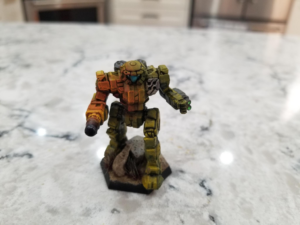
Alright, so I’ve only been painting minis for a little over six months now and I’m still learning a lot. One technique I’m really interested in learning is Object Source Lighting (OSL for short). Basically: how do you make it look like the mini is being lit by a lantern they’re holding (or some other light source). Last week, I was painting a Victor and the model’s right arm is just the barrel of an autocannon. It has some exposed heat sinks right next to the arm, so after doing my usual quick base coating steps, I pivoted to trying to make it look like it had just recently fired the autocannon and the glow from the heat sinks is still lighting up the side of the torso.
The thing about the Victor is that it’s designated as an Assault mech (one of the heaviest mech classses in the setting, known for being big, slow, and heavily armoured). Except its armour is much closer to that of a Medium mech. For reference, the stock Victor 9B is 1370 BV (assuming 4/5 pilot stats) but only has a few extra points of armour than the Nightsky does. Sure, it has more rear armour and internal structure, but it’s also packing ammo bins for its Short-Range Missiles (SRMs) and its AC/20. There’s enough ammo for the autocannon that I could load it up with precision or armour piercing ammo, just to make things hurt a little more. I ultimately brought the Victor as a backup because this is my first time going to an event with this group and every Battletech group seems to be a little different. If someone objects to me bringing this much pulse laser to the table between my Spider and Nightsky, I can sub the Victor in instead of the Nightsky. The 20 point differential between the Victor and the Banshee gives me just enough room to squeeze my jumpy lad into the list.
A quick note on balance in Battletech. Classic Battletech uses a points system to assign a general value based on a mech’s loadout, armour, and other capabilities (Alpha Strike has a totally separate balancing/points system that seems to be a little harder to exploit – another reason why I quite like AS). This is expressed as the mech’s battle value or BV. The BV system is remarkably robust for something that came out in 1997 and last saw a revision in 2007. It can, however, be exploited in some ways. Battletech is a complicated and often time-consuming game to play, and the easiest way to ensure you have a stable pool of folks to play with is to not be a tryhard dickhead at pickup games. For more about how not to be a tryhard dickhead, see: Battletech: BV and The Code. The pulse lasers referred to in that article are Clan pulse lasers and not available on the variants I’ve chosen, but get a few Battletech players in the room and ask them what they think is completely broken in the setting and you’ll usually have four or five completely different opinions. I didn’t want to be the player who happened to pull up with a list that led to a shouting match the last time they ran this match type.
At any rate, I double-checked to see if my lists needed to be submitted before I showed up to the event (they did not, as this was just a casual game) and let myself make the call right before the start of the game. After chatting with the organizer when I got there, I ultimately opted for the Jumpy Pulse Bastards and let my Victor rest in the tupperware container I brought the squad in.
With that overly long setup behind us, let’s get to the After Action Report.
The After Action Report
Upon arrival at the shop, I was asked who my sponsor was for the Solaris VII fight. I hadn’t even considered this and was a little frazzled from the drive in to Toronto. After collecting myself, I went with Yoyodyne, the only too-precious-by-half big-L Literature reference I’ll allow myself. I realized afterwards that there was a wealth of Netrunner corps I could’ve used or, hell, even a better Pynchon reference than that. But whatever, Yoyodyne is also the name I give to my Etrian Odyssey guild, too. The sponsor wound up being the shorthand they’d use to refer to the different players around the table. There were about five of us. Nobody brought more than two mechs. I was heartened to see that a lot of folks were rolling with mech variants that I quite liked: I saw a Wolverine WVR-7K in there, one guy had a Centurion CN9-AH. As I am always pleased by the overall aesthetics of the Axmans and Hatchetmans (sorry, this is just how plurals are handled in the setting – I hate it too) I was happy to see that the organizer brought an Axman. There was also a Wraith (a mech I like almost as much as the Nightsky) and oh fuck oh no somebody brought the Banshee 3Q (they used a Wasp to fulfill the two-mech requirement).
Initiative was handled with a deck of cards rather than having players roll off. I liked this approach. Everyone took turns cutting the initiative deck between shuffles and that established the order. Then it would reverse order. So whoever moved their first mech last got to move both mechs one after the other. If one of your two mechs were dead, you automatically got to skip the first mech movement because everyone wants to move as late as possible to avoid giving someone the chance to get into their rear arc. We all rolled off to see who would spawn where on the map (your starting point was randomized by rolling a 1D6 and moving clockwise around the table to the correct spot).
This photo was taken after the game, but should give you an idea of the forces and their composition.
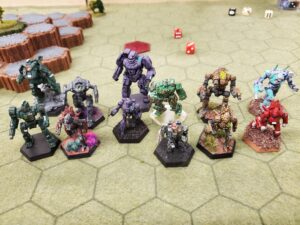
From left to right:
- Corean Enterprises (Shadow Hawk and Centurion)
- Yoyodyne Ltd. (Nightsky and Spider) – it’s a me
- Venu Corporation (Banshee and Wasp) – oh no
- Cool Guy Industries (Wolverine and Wasp)
- Cyberdyn Systems (Axman and Spider) – the TO
- Lunar Gambit Inc (Wraith and Spider) – this was a very close contender for my lineup, too.
Turn 1: Getting into Position
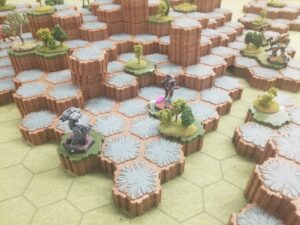
We were playing with sprint rules, so you could choose to sprint for twice your walk speed, but would not be able to shoot or make any physical attacks. I’m pretty sure I just jumped to the woods rather than sprint. I didn’t fire anything this turn, though. You can see in the distance Cyberdyn’s Axman and Spider. That Axman looked cool as hell and had a sick freehand logo on it.
Turn 2: First Blood
Lunar Gambit’s Spider jumped onto the summit alongside Venu Corporation’s Spider. I was still getting into position and saw an opportunity to get a rear
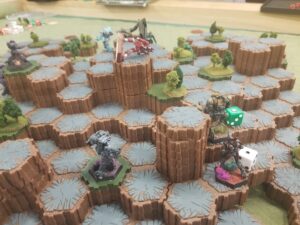
armour shot in on the Axman with my Spider, but that wasn’t going to do an awful lot. Just wanted to get some shots in. I also unloaded into the rear armour of Lunar Gambit’s Spider with my Nightsky and cored it (several other folks were taking potshots at it, too). Spiders can be fragile, even with decent difficulty-to-hit modifiers. A lot of light mechs will rely on the “to-hit” difficulty increasing as they move, but if enough people are pouring shots into you, someone’s going to roll boxcars and take off a leg.
Turn 3: More Blood
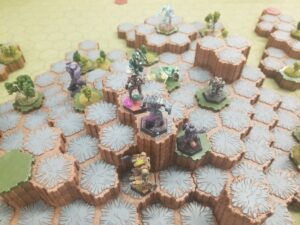
I jumped my Spider and Nightsky onto the summit, scoring a point each. Vanu’s Banshee managed to get a shot in on Cyberdyn’s Spider with the AC/20, which ended that mech’s run. I got a point for taking some shots at them, too, if I recall correctly. Then Vanu’s Banshee kicked Corean Enterprises’ Centurion’s head off during the physical attacks phase.
Turn 4: Coolant Flush
I hopped my Nightsky and somehow unscathed Spider off the summit. My Spider had been building up heat over the past few turns and I wanted it to cool off a bit. Cool Guy Industries put his Wasp on the summit (it promptly had a leg shot off) and it looked like next turn was going to be a bloodbath. Cyberdyn’s Axman got behind Cool Guy’s Wolverine and dismantled its right torso.
Turn 5: Violence Ensues
My Nightsky put some shots in on Cool Guy’s Wasp along with help from Lunar Gambit’s Wraith and Venu’s Banshee. Lunar Gambit’s Wraith also got a headshot on Corean Enterprises’ Shadow Hawk, meaning both of their mechs went out with headshots.
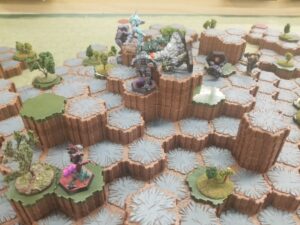
Turn 6: Repositioning
My Spider got back on the summit, my Nightsky tried to hatchet someone but missed. A lot of folks jockeying for position and taking potshots.
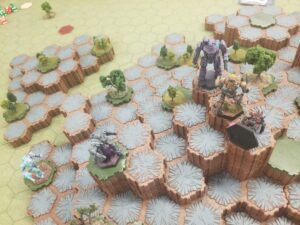
Turn 7: Death From Above
My Spider took an AC/20 shot to the arm and sundry other fire to the leg. Still around but it’s not getting up. I was just hoping it would last long enough to get two points. Then Lunar Gambit declared a death from above from their Wraith. The Axman and Banshee were getting into it next to my Spider. The Banshee also made a push attack, so we had to figure out a lot of displacement order-of-operations. The Wraith landed on my Spider, which was badly damaged and knocked off the cliff (the fall finally killed it). Then the Banshee pushed the Axman into the Wraith, pushing the Wraith off the summit.
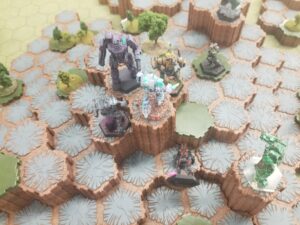
Turn 8: Back on Top
Vanu’s Banshee is still on the summit. Cool Guy’s Wasp tried to charge the Banshee off the summit but took an AC/20 to the leg and Cyberdyn’s Axman finished the job with a hatchet.
Turn 9: Endgame
The newly-resurrected Centurion from Corean Enterprises finally got back into the fight in time to shred the rear armour of Axman with an AC20 shell. It’s now hanging together with duct tape and a prayer. After two turns of sustained fire from several other mechs, was the victim of *another* Death from Above attack from the Wraith. This displaced it off the top of the mountain. The pilot decided to eject, ending the match (for the game to be called, three players needed to lose all three of their mechs). My Nightsky and Cool Guy Industries’ Wolverine exchanged a perfunctory salvo of fire and shook hands at having ended the match still alive on the summit.
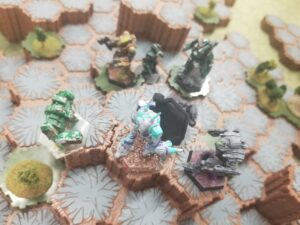
Final Thoughts
My main lessons so far:
- Use Flechs record sheets (or ideally, get a decent tablet or e-ink setup to handle record sheets). Cognitive load is a real threat and the less brainpower you spend thinking about basic mechanics, the more you can use it making better choices. At any rate, the stock record sheets from Catalyst are pretty low on details. I should also take a closer look at the Fancy Record Sheets.
- You are going to forget everything you thought you knew once you play your first game. I am super grateful to everyone at the table for being chill and helpful as I mostly stumbled through just about every single phase.
- For this particular format, armour is king. Your point totals increase exponentially and with the BV limitations, you need to be able to reliably tank multiple AC/20 shots. I get that there’s a lot of hand-wringing about the balance of the game after the Clan Invasion introduced a lot of higher-level tech, but that Banshee was basically unstoppable. Nobody had an answer for it. I think if we’d allowed at least some early Clan tech, someone might have had the requisite DPS to really stop that thing, especially considering the player dumped half its ammo bins at the start. This is a very specific inside baseball tip to anyone looking to pick up a Banshee – you might want to avoid the one in the Eridani Light Horse Hunter Lance Pack. The way it’s posed on the base makes it extremely hard to figure out its facing. Compare the Inner Sphere Heavy Lance mini against the Eridani Light Horse one. The second Banshee is explicitly not aligned to the flat edge of the hex. Unless you’ve marked the facing side of the hex, it’s impossible to tell from looking at the table.
- As I get better at the game, I could also see taking a very different approach to this format if I just wanted to fuck around with artillery. I wouldn’t be able to bring Urbanmech AIVs, unfortunately (they show up in the 3070s). However, I could fuck around with some kind of Catapult C3/OstScout force. Five shots with Arrow IV ammo isn’t enough for a full engagement, but it might be funny to just rain artillery shots down on the summit in the late game. If I were to run this format on my own, I think I’d consider opening up the option of providing players with battlefield support points, a much easier, rules-lite way to introduce artillery and fire support to the game.
- In the intervening time, the recent Battletech: Mercenaries Kickstarter has started shipping. I missed out on the chance to back it, but I’ve devoured every bit of coverage I can find about how the new rules handle support assets as well as rolling your own mercenary company. It seems like there’s some really elegant ways to roll a scenario up to play a quick pickup game with an opponent. A more expanded version of those rules should be coming out in the Hot Spots: Hinterlands book at the end of November, so I’m excited to check that out. A local place near me has started having semi-regular Alpha Strike drop-in sessions, so I might pitch a couple folks on rolling a contract and playing a quick match.
- It is endlessly funny to me how many lance packs have one or two assault mechs in the box. It’s super rare that I’d ever throw more than one in a force if I’m playing Classic Battletech. What I’m starving for is decent Heavy, Medium, and Light mechs to fill out a force. My entire conundrum around finding a light mech to pair with the BNC-3Q that I wanted to run would’ve been solved if I had an Ostscout or Javelin. I may also die mad that my beloved Vindicator (a very good Medium mech) is locked to the Beginner Box, so I need to hope I get lucky with a blind box or spend $25 for that mech, a spare Griffin, some new hex maps and streamlined beginner rules… hey okay maybe that’s not too steep a price for all that. God damn it. [Editor’s note: they did, in fact, decide it was not too steep a price for all that. This post will be updated with a photo once the painting’s done.]